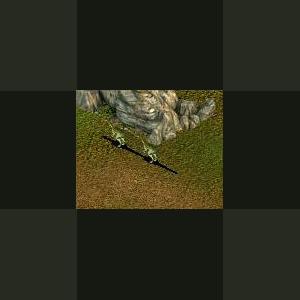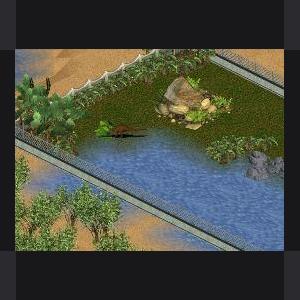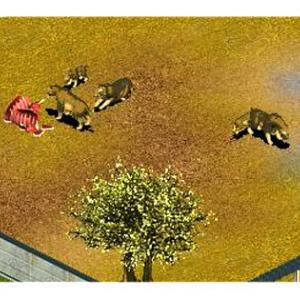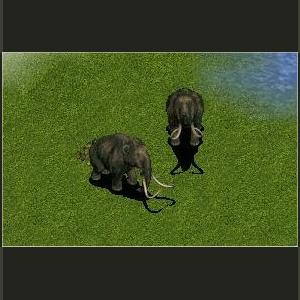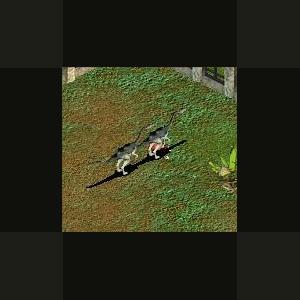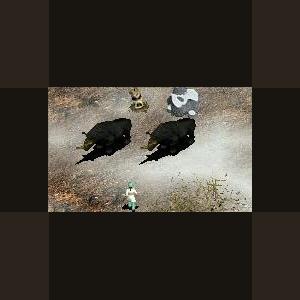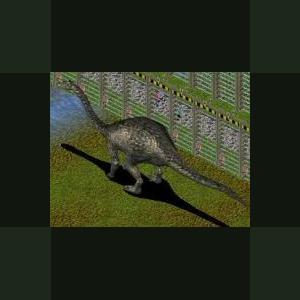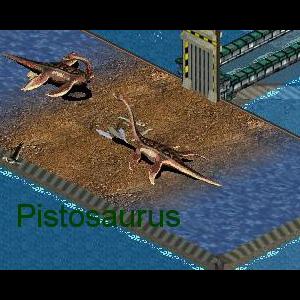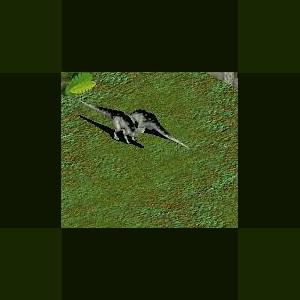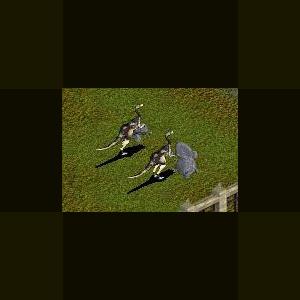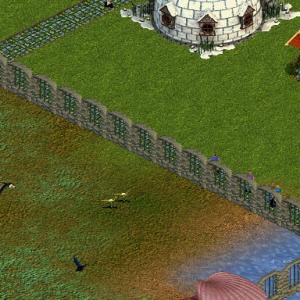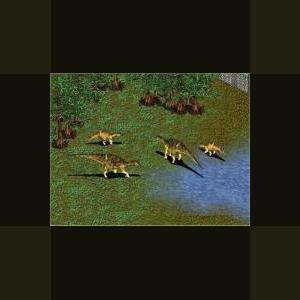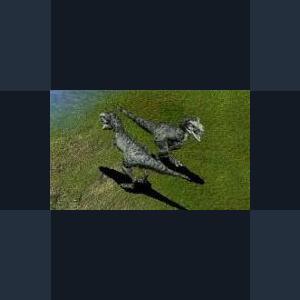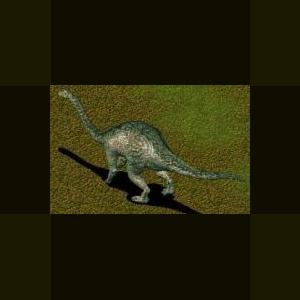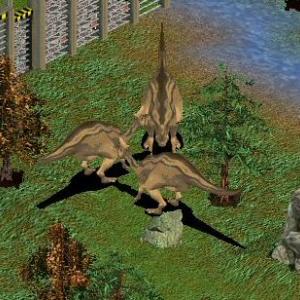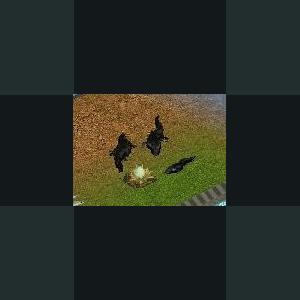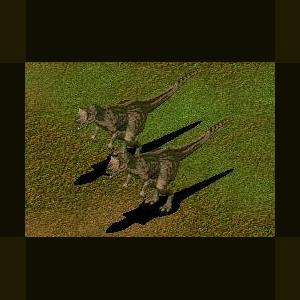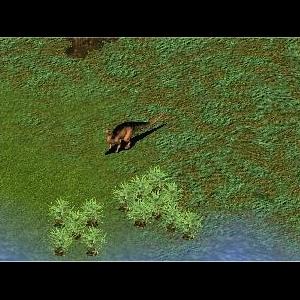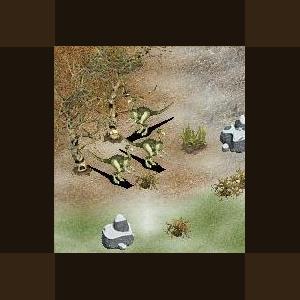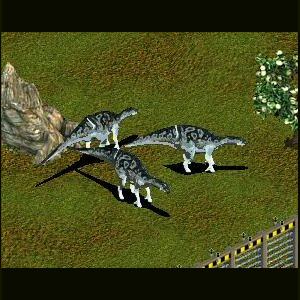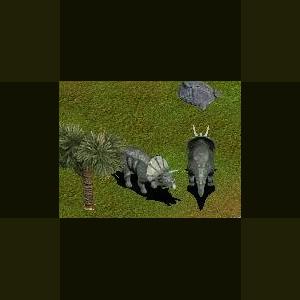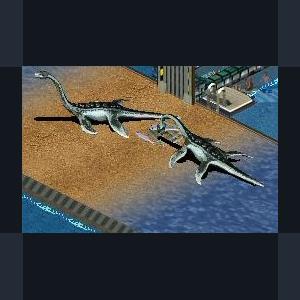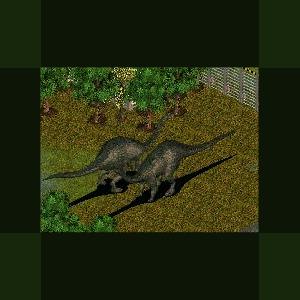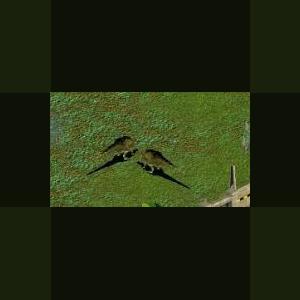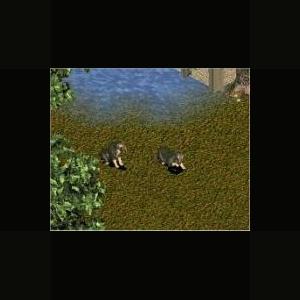Dinosaurs
Creatures from another age
241 files
-
Procompsognathus by Moondawg
By Guest
Procompsognathus was a small archosaur that lived during the Late Triassic Period, about 222 to 219 million years ago.
Procompsognathus was named by Eberhard Fraas in 1913. He named the type species, P. triassicus, on the basis of a poorly-preserved skeleton found in Württemberg, Germany.
The name is derived from Compsognathus meaning 'elegant jaw' (Greek kompsos meaning 'elegant', 'refined' or 'dainty' and gnathos meaning 'jaw'), which was a later (Jurassic) dinosaur. The prefix pro implies 'before' or 'ancestor of', although this direct lineage is not supported by subsequent research.
While it is undoubtedly a small, bipedal carnivore, the extremely poor preservation of the only known Procompsognathus fossil makes its exact identity difficult to determine. It has historically been considered a theropod dinosaur, though some, such as Allen (2004), have found Procompsognathus to be a primitive, non-dinosaurian ornithodiran. Sereno and Wild (1992) stated that the holotype specimen consisted of fossils from two separate animals. They referred the skull to the primitive crocodylomorph Saltoposuchus, and the remainder of the skeleton to a ceratosaur related to Segisaurus. Rauhut and Hungerbuhler (2000) noted features of the vertebrae which suggest that Procompsognathus may be a coelophysid or ceratosaur, and Carrano et al. (2005), in their re-study of the related genus Segisaurus, found both Segisaurus and Procompsognathus to belong to the Coelophysidae within Dinosauria.
In Michael Crichton's novels Jurassic Park and The Lost World, Procompsognathus (often referred to as "compys") are one of the extinct species recreated through genetic engineering. Crichton portrays these dinosaurs as being venomous, a characteristic invented for the novel and not supported by fossil evidence. He also portrays them as scavengers and coprophagists (eaters of feces), useful in keeping the park clean of sauropod excrement. In the film adaptation of The Lost World, Procompsognathus were replaced with the distantly related coelurosaur Compsognathus. However, in the second film, Robert Burke refers to them as Compsognathus triassicus (triassicus being the type species of Procompsognathus).
169 downloads
0 comments
Updated
-
Mokele Mbembe by Ghirin
By Guest
Mokele-mbembe, a name that means "One who stops the flow of rivers", is a legendary animal from the Likouala swamp region of the Central African Republic. It is usually described as having a small head on a long neck, a long, tail, rounded feet with three claws on each foot, and to be intermediate in size between an elephant and a hippopatamus The skin is hairless and reddish brown in color.
Mokele-mbembe is said to live in the pools and wetlands near rivers. It is herbivorous, prefering the malambo plant (Landolphia sp.). The animal is reported to spend most of its time in the water, only coming onto dry land to feed.
Some cryptozoologists believe that Mokele-mbembe is a surviving population of sauropod dinosaurs from the Mesozoic era. Many reports of the creature have come from the Congo region and several expeditions have been organized, but no actual specimenes, living or dead have been recovered for scientific study.
*Inspired by the Zoo Tycoon Brains Trust at the Zoo Tek Forums.
References:
http://www.mokelembembe.com/
http://www.geocities.com/Area51/Cavern/7270/mokele.html
http://www.angelfire.com/mi/dinosaurs/mokele.html
http://www.occultopedia.com/m/mokele_mbembe.htm
Created by Ghirin 2004
312 downloads
0 comments
Updated
-
Machairodus Giganteus by Ghirin
By Guest
Machairodus was a genus of large saber-toothed cats found in Eurasia, Africa and North America. These sabertooths thrived over the period covered by the mid-Miocene to the mid-Pliocene (15 to 2 million).
Machairodus giganteus, the size of a modern lion or tiger, was the largest and most specialized member the genus in Eurasia. Its skull was longer and narrower than a modern lion and the teeth had serrations along the edges.; in addition, M. giganteus also had longer legs than some other species of Machairodus. There was a small flange on either side of the chin to provide support for the sabers when the mouth was closed.
It lived in mixed habitats of savannah and broadleaf evergreen trees and might have had a lifestyle similar to that of modern lions. M. giganteus also might have had a tawny brown coat to help it blend in with its surroundings.
Referrences:
Big Cats and Their Fossil Relatives by Anton, Clark and Turner, 2000.
Mammoths, Sabertooths and Hominids by Agusti and Anton, 2002.
http://www.bluelion.org/lowgraphmachairodus.htm
Created by Ghirin 2003
373 downloads
0 comments
Updated
-
Steppe Mammoth by Ghirin
By Guest
Steppe Mammoth by Ghirin
The steppe mammoth (Mammuthus trogontherii) lived on the steppes that covered large portions of Eurasia.
This grassland was south of the ice sheets, but was still colder than the steppes of today.
The steppe mammoth may be descended from the ancestral mammoth, Mammathus mridionalis. It gave rise to the woolly mammoth of the late Pleistocene.
*Inspired by the Zoo tycoons brains trust at the Zoo Tek Evolved Forums.*
443 downloads
0 comments
Updated
-
Archaeornithoides by Moondawg
By Guest
Archaeornithoides is a genus of maniraptoriform theropod dinosaur. It was found in Late Cretaceous river sandstones of the Djadokhta Formation beds located in Bayn Dzak,Mongolia.
The generic name (Archaeornithoides) means “shaped like an ancient bird” in ancient Greek. The specific descriptor (deinosauriscus) alludes to the animal's small size for a dinosaur.
Elzanowski & Wellnhofer (1993) suggested that Archaeornithoides was the closest known relative to birds Avialae. This conclusion rested on key bird-like features; an interdigitated suture between the premaxilla and maxilla, broad palatal shelves, pneumatic sinuses, lack of interdental plates, and unserrated teeth. Since publication, though, all of these features have been discovered in new fossils of adult and/or juvenile troodonts and dromaeosaurs.
Elzanowski and Wellnhofer noted that the specimen has distinct bite marks, and suggested that its braincase was bitten off by a deltatheridiid (Deltatheridium) mammal the size of a weasel (adding that these are common in the Bayn Dzak assemblage). Clark and colleagues (2002) noted that it may have also passed through the digestive tract of the predator before fossilization. If true, this may be the first known evidence of Mesozoic mammals eating dinosaurs (see Repenomamus).
278 downloads
0 comments
Updated
-
Elasmotherium Sibiricum by Moondawg
By Guest
I remade this animal for Pukkie ... I also remade this animal for those Tekkies who would prefer the Black version to the Grey...
There is nearby a wide steppe, and there dwells, it is told, an animal smaller than a camel, but taller than a bull. Its head is the head of a ram, and its tail is a bull’s tail. Its body is that of a mule and its hooves are like those of a bull. In the middle of its head it has a horn, thick and round, and as the horn goes higher, it narrows (to an end), until it is like a spearhead. Some of these horns grow to three or five ells, depending on the size of the animal. It thrives on the leaves of trees, which are excellent greenery. Whenever it sees a rider, it approaches and if the rider has a fast horse, the horse tries to escape by running fast, and if the beast overtakes them, it picks the rider out of the saddle with its horn, and tosses him in the air, and meets him with the point of the horn, and continues doing so until the rider dies. But it will not harm or hurt the horse in any way or manner.
289 downloads
0 comments
Updated
-
Aragosaurus by Moondawg
By Guest
Aragosaurus (meaning "Aragon lizard") was a genus of sauropod dinosaur from the Early Cretaceous period of Galve, Teruel, in the province of Aragón, Spain.
Aragosaurus was a large, quadrupedal plant-eating (herbivorous) dinosaur, which lived about 130-120 million years ago, in the Hauterivian-Barremian. It was about 60 ft (18 m) in length and about 28000 kg in weight.
Like other sauropods, it had a long neck, a long powerful tail, a small head and a bulky body. It was broadly similar to Camarasaurus. It is represented by a partial fossil, which was found in Spain and was named by Sanz, Buscalioni, Casanovi and Santafe in 1987. The type species is A. ischiaticus. Like Camarasaurus, Aragosaurus probably had a short, compact skull and a moderately long neck. The teeth were large and wide, and would have been useful for slicing through the leaves and branches of tall conifer trees. The forelimbs were only a little shorter than the hind limbs, and the tail was long and muscular.
309 downloads
0 comments
Updated
-
Pistosaurus by Moondawg
By Guest
Pistosaurus longaevus is an extinct genus of aquatic sauropterygian reptile belonging to the plesiosaur order.
PISTOSAURUS
(pronounced PIST-oh-SAWR-us) Pistosaurus was a nothosaur, a reptile with flipper-like limbs that lived both on land and in the water. It was about 10 feet (3 m) long with a very long neck, four long, paddle-shaped flippers, a streamlined body, and many sharp, pointed teeth in long jaws. Fossils have been found in France and Germany. It lived during the mid-Triassic period. It was not dinosaur
228 downloads
0 comments
Updated
-
Aralosaurus by Moondawg
By Guest
Aralosaurus (ar-ahl-o-SORE-us) meaning "Aral Sea lizard", because it was found in the Aral Sea when it began to shrink noticeably.Aralosaurus was a genus of hadrosaurid dinosaur which lived during the Late Cretaceous of what is now Kazakhstan.
Aralosaurus was characterized by a small, bony peak on its nose, much like its relatives Maiasaura and Gryposaurus. Some paleontologists have posited that Aralosaurus was actually a lambeosaurine.
Aralosaurus was a herbivore that lived in the late Cretaceous period, around 95 to 80 million years ago, and was capable of both bipedal and quadrupedal movement. Egg clusters show that Aralosaurus lived in herds and had locations for laying eggs where they would be safe.Several relatives, such as Jaxartosaurus have also been found in the surrounding area where Aralosaurus was found.
Aralosaurus was about the size of an elephant, being up to 9 m long, but was over 5,000 kilograms in weight. Although very little is known about Aralosaurus (only one near complete skull has been found); it was identified by a beak with nearly 1,000 small teeth in 30 rows. These teeth were used for breaking up plant matter by chewing, a feature common in herbivorous dinosaurs, but unusual for reptiles.The back of an Aralosaurus skull was wide, a feature suggestive of large jaw muscles used to power its chewing apparatus
334 downloads
0 comments
Updated
-
Avimimus by Moondawg
By Guest
Avimimus was a small dinosaur, standing about 45 centimeters (2.5 ft) tall at the hips and
a length of 1.5 m (5 ft). The skull was relatively small compared to the body, though the
brain and eyes were relatively large. The size of the bones which surrounded the brain and
were dedicated to protecting it are large. This is also consistent with the hypothesis
that Avimimus had a proportionally large brain.
As in the related Oviraptoridae and Caenagnathidae, the jaws of Avimimus formed a
parrot-like beak, and lacked teeth. However, a series of toothlike projections along the
tip of the premaxilla would have given the beak a serrated edge. The toothless beak of
Avimimus suggests that it may have been an herbivore or omnivore. Kurzanov himself,
however, believed that Avimimus was an insectivore.
The foramen magnum, the hole allowing the spinal cord to connect with the brain, was
proportionally large in Avimimus. The occipital condyle, however, was small, further
suggestive of the skull's relative lightness.The neck itself was long and slender, and is
composed of vertebrae are much more elongate than in other oviraptorosaurs. Unlike
oviraptorids and caenagnathids, the back vertebrae lack openings for air sacs, suggesting
that Avimimus is more primitive than these animals.
The forelimbs were relatively short. The bones of the hand were fused together, as in
modern birds, and a ridge on the ulna (lower arm bone) was interpreted as an attachment
point for feathers by Kurzanov.Kurzanov, in 1987, also reported the presence of quill
knobs, and while Chiappe confirmed the presence of bumps on the ulna, their function
remained unclear. Kurzanov was so convinced they were attachment points for feathers that
he concluded that Avimimus may have been capable of weak flight. This interpretation has
not seen wide support among paleontologists, however.
The ilium was almost horizontally oriented, resulting in exceptionally broad hips. Little
is known of the tail but the hip suggests that the tail was long. The legs were extremely
long and slender, suggesting that Avimimus was a highly specialized runner. The
proportions of the leg bones add further weight to the idea of Avimimus was quick on its
feet. The animal's shins were long in comparison with its thighs, a trait common among
cursorial animals. It also had three-toed feet with narrow pointed claws.
Its remains were discovered in the Djadokta Formation by Russian paleontologists, and
officially described by Dr. Sergei Kurzanov in 1981. The type species is A. portentosus.
Because no tail was found with the original find, Dr. Kurzanov mistakenly concluded that
Avimimus lacked a tail in life. However, subsequent Avimimus finds containing caudal
vertebrae have confirmed the presence of a tail.
In 1991, Sankar Chatterjee erected the Order Avimimiformes to include Avimimus, though
this group is not used by most paleontologists today as it includes only a single species.
283 downloads
Updated
-
0 comments
Updated
-
Edmontosaurus by Ghirin
By Guest
Edmontosaurs
Author: Ghirin
Edmontosaurus was the most abundant genus of herbivore at the end of the Cretaceous period. Many skeletons have been found, including ones with mummified skin.
*Inspired by the Zoo Tycoon Brain Trust at the Zoo Tek Evovled Forums*
364 downloads
0 comments
Updated
-
Aviatyrannis by Moondawg
By Guest
Aviatyrannis is a genus of tyrannosaurid dinosaur from the Kimmeridgian stage of the Late Jurassic found in Portugal.
It was described by Oliver Rauhut in 2003. The name means "Jurassic grandmother tyrant". It is one of the oldest tyrannosaurs ever found, the oldest being Guanlong (or Iliosuchus if it is indeed tyrannosauroid).
Aviatyrannis was perhaps a contemporary of another ancient tyrannosaur, the American Stokesosaurus. Aviatyrannis was even originally assigned to Stokesosaurus, and its fragmentary remains maintain the question of their synonymity open.
Like other early tyrannosaurs, Aviatyrannis was rather small. The holotype, for example, is an ilium only 90 millimeters long. The type species, Aviatyrannis jurassica, was described by Rauhut in 2003.
Inspired by the Zoo Tek Brains Trust
226 downloads
Updated
-
Antarctosaurus by Moondawg
By Guest
Antarctosaurus (pronounced as ; meaning "southern lizard") is a genus of titanosaurian sauropod dinosaur from the Late Cretaceous Period of what is now South America.
Antarctosaurus was very large, even for a dinosaur. Scientists still have much to learn about Antarctosaurus, as a complete skeleton remains elusiveAntarctosaurus was a huge quadrupedal herbivore with a long neck and tail. It was possibly armored. As Antarctosaurus is not known from a complete skeleton[1] and tail lengths are highly variable among sauropods, the true size of these animals is hard to extrapolate. The type species may have been over 60 feet (18 meters) long, and a second species may have been one of the largest land animals ever. Antarctosaurus may have been as tall as 15 feet at the shoulder.
Remains of this dinosaur were first mentioned in print in 1916, although they were not fully described and named until a 1929 manuscript written by paleontologist Friedrich von Huene. Antarctosaurus does not refer to the continent of Antarctica, since it was first found in Argentina, although it does have the same derivation, from the Greek words anti- meaning 'opposite of', arktos meaning 'north' and sauros meaning 'lizard'. The generic name refers to the animal's reptilian nature and its geographical location on a southern continent.r
271 downloads
0 comments
Updated
-
Corythosaurus by Moondawg
By Guest
Corythosaurus
Corythosaurus meaning 'helmet lizard' because of the shape of its crest (Greek korythos meaning 'helmet' and sauros meaning 'lizard') was a genus of duck-billed dinosaur from the Upper Cretaceous Period, about 80 million years ago. It lived in what is now North America.
The first specimen was discovered in 1912 by Barnum Brown in Red Deer River, Alberta, Canada. As well as an almost complete skeleton, the find was remarkable because much of the creature's fossilized skin had also survived. In 1916, the Canadian (Canadian Pacific Lines) ship Mount Temple was carrying two specimens and other fossils from today's Dinosaur Provincial Park, Alberta, Canada to Britain. It was sunk by the German surface raider SMS Moewe, sending its 75 million year old cargo to the bottom of the North Atlantic, where it rests to this day.
There were originally up to seven species described including C. casaurius, C. bicristatus, C. brevicristatus, C. excavatus, C. frontalis, and C. intermedius. In 1975 Peter Dodson studied the differences between the skulls and crests of different species of lambeosaurine dinosaurs. He found that the differences in size and shape may have actually been related to the gender and age of the animal. Now only one species is recognized, C. casuarius.
Corythosaurus is classified as a hadrosaurid, in the subfamily Lambeosaurinae. It is related to other hadrosaurs such as Hypacrosaurus, Lambeosaurus and Olorotitan, with the exception of Olorotitan they all share similar looking skulls and crests. However, recent research has suggested that Olorotitan is Corythosaurus closest known relative even though it doesn't share as many skull characteristics as other lambeosaurs.
Corythosaurus weighed in at 4 tonnes and measured roughly 10 metres (35 ft) from nose to tail. Like other hadrosaurs it had a toothless beak, the back of the jaws contained a dental battery composed of hundreds of small, interlocking teeth. These were used to crush and grind plant matter and were continually replaced as they wore away.
Over 20 skulls have been found from this dinosaur. As with other lambeosaurs, the animal bore a tall, elaborate bony crest atop its skull, which contained the elongate nasal passages. The nasal passages extended into the crest, first into separate pockets in the sides, then into a single central chamber and onward into the respiratory system.
Any vocalization would travel through these elaborate chambers, and probably get amplified. Scientists speculate that Corythosaurus could make loud, low pitched cries "Like a wind or brass instrument." The sounds could serve to alert other Corythosaurus to the presence of food or a potential threat from a predator.
It was once thought that this dinosaur lived mostly in the water, due to the appearance of webbed hands and feet. However, it was later discovered that the so-called "webs" were in fact deflated padding, much like that found on many modern mammals.
319 downloads
0 comments
Updated
-
Brachychampsa by Moondawg
By Guest
This freshwater, carnivorous reptile is among the very earliest alligatoroids known to science.
The first Brachychampsa fossil was discovered in Montana's heck Creek Formation—an ancient suite of rocks that was laid down near the end of the Cretaceous period. That individual animal lived not so long before the Cretaceous-Tertiary extinction that wiped out many of Earth's species some 65 million years ago.
Brachychampsa had short teeth and a large mouth that packed more power than those of living gators. These oral characteristics suggest that Brachychampsa may have preyed on turtles, which were very common in the heck Creek fauna.
The first alligator ancestors evolved some 245 million years ago. About 80 million years ago, during the Cretaceous period, crocodilians appeared. This group includes alligatoroids, such as Brachychampsa, as well as their close relatives the crocodiles and caimans.
Many of these ancient animals were survivors of the Cretaceous-Tertiary extinction, though no one knows why they lived when so many others perished.
Modern alligators are still closely related to their ancient ancestors and look much like their relatives did 80 million years ago.
This animal was tricky :D but i managed to get the eggs to hatch :D
273 downloads
0 comments
Updated
-
Carcharodontosaurus by Moondawg
By Guest
Carcharodontosaurus was a gigantic carnivorous carcharodontosaurid dinosaur that lived around 98 to 93 million years ago, during the Cretaceous Period.
It was nearly as long as Tyrannosaurus, growing to an estimated 11.1-13.5 meters (36-44 feet) and weighing up to 2.9 metric tons. The name Carcharodontosaurus means 'shark lizard', after the shark genus Carcharodon (from the Greek karcharo meaning 'jagged' and odonto meaning 'teeth') and sauros, meaning 'lizard'
Carcharodontosaurus was a carnivore, with enormous jaws and long, serrated teeth up to eight inches long. Paleontologists once thought that Carcharodontosaurus had the longest skull of any of the theropod dinosaurs. However, the premaxilla and quadrate bones were missing from the original African skull, which led to misinterpretion of its actual size by researchers. A more modest length of 1.6 meters (5.2 ft) has now been proposed for C. saharicus, and the skull of C. iguidensis is reported to have been slightly larger at 1.75 m in length (5.5 ft). Still, the honor of the largest theropod skull now belongs to another huge carcharodontosaurid dinosaur, the closely related Giganotosaurus (with skull length estimates up to 1.95 m) (6.3 ft).
The Endocranial cast, of the impression of the brain on the inside of the skull, and inner ear anatomy of Carcharodontosaurus saharicus resembled modern Crocodylia.The size of the cerebrum relative to the total brain was similar to modern reptiles, but small relative to coelurosaurian theropods and birds.
Carcharodontosaurus fossils were first found by Charles Depéret and J. Savornin in North Africa in 1927. Originally called Megalosaurus' saharicus(many theropods were once erroneously referred to as Megalosaurus), its name was changed in 1931 by Ernst Stromer von Reichenbach to that used today. Stromer named Carcharodontosaurus "for its mainly Carcharodon-like teeth", which were "not recurved, almost bilaterally symmetrical but with convex edges." These first fossils of Carcharodontosaurus were destroyed during World War II. However, cranial material from a Carcharodontosaurus was again discovered in Morocco in 1996 by paleontologist Paul Sereno. Stephen Brusatte and Paul Sereno reported a second species of Carcharodontosaurus, differing from C. saharicus in some aspects of the maxilla and braincase. This second species, which was discovered in Niger in 1997, was named C. iguidensis in December of 2007.
269 downloads
Updated
-
Draconyx by Ghirin
By Guest
Draconyx
Author: Ghirin
Draconyx's ("Dragon Claw") fossils were found in Portugal. It was similar in size and build to Camptosaurus.
*Inspired by the Zoo Tycoon Brain Trust at the Zoo Tek Evolved Forums.
237 downloads
0 comments
Updated
-
Leaellynasaura by Moondawg
By Guest
Leaellynasaura
Leaellynasaura was a small herbivorous ornithopod dinosaur of about 60-90 cm in length from the earliest Cretaceous, first discovered in Dinosaur Cove, Australia.
It was an Australian polar dinosaur. Strangely enough, at this period in time, Victoria would have been well within the Antarctic Circle, which is now very cold. This means that Leaellynasaura was living and apparently thriving much further south than any reptile could today. This is particularly relevant due to Cryolophosaurus being discovered in Antarctica, thus further suggesting the idea that dinosaurs could live under conditions which were once thought unsuitable for their kind. It is possible that the sun would not have risen for several weeks or months in the winter, depending on latitude, which means that Leaellynasaura would have had to live in the dark for perhaps months at a time. This is particularly relevant to the fact that Leaellynosaura had very big eyes and its brain had large optic lobes, as if it had evolved to be routinely active in the dark.Evidence found on the coast of western Victorian coastline suggests that polar dinosaurs, such as Leaellynasaura, may have dug burrows to nurture their young during the polar winter.
Regardless, the fact that it lived in extremely cold temperatures led many scientists to believe that Leaellynasaura was warm-blooded.
No complete skeletons have been found of Leaellynasaura. The species is known from many isolated limb bones, ribs, vertebrae, jaws, teeth and one partial skull.
The type species is Leaellynasaura amicagraphica. It was described in 1989. It was named after Leaellyn Rich, the daughter of the palaeontologist couple Tom Rich and Patricia Vickers-Rich who discovered it. Leaellynasaura was a hypsilophodont, a rather basal ornithopod. Like all ornithopods, it was a herbivore.
308 downloads
Updated
-
Jinzhousaurus by Moondawg
By Guest
Jinzhousaurus
Jinzhousaurus is a genus of hadrosauroid dinosaur. Its fossils, consisting of a nearly complete skeleton, were found in the Dawangzhangzi Beds of the Yixian Formation in Liaoning, China (dating to 122 million years ago, during the early Aptian stage of the early Cretaceous Period).The type (and currently only known) species is Jinzhousaurus yangi. It was first described by Wang Xiao-lin and Xu Xing in 2001.
193 downloads
0 comments
Updated
-
Zuniceratops by Moondawg
By Guest
Zuniceratops
Zuniceratops ('Zuni-horned face') was a Ceratopsian dinosaur from the mid Turonian of the Late Cretaceous Period of what is now New Mexico, United States. It lived about 10 million years earlier than the more familiar horned Ceratopsidae and provides an important window on their ancestry.
Zuniceratops appears to have been roughly 10-11 feet (three to 3.5 meters) long and three feet (one meter) tall at the hips. It probably weighed 200 to 250 pounds (100 to 150 kilograms). The frill behind its head was fenestrated but lacking epoccipitals. It is the earliest-known ceratopsian to have eyebrow horns and the oldest-known ceratopsian from North America. This set of horns is thought to have grown much larger with age.
Zuniceratops was discovered in 1996, by 8 year old Christopher James Wolfe, son of paleontologist Douglas G. Wolfe, in the Moreno Hill Formation in west-central New Mexico. One skull and the bones from several individuals have been found. More recently, one bone, believed to be a squamosal, has since been found to be an ischium of a Nothronychus.
Zuniceratops is an example of the evolutionary transition between early ceratopsians and the later, larger ceratopsids that had very large horns and frills. This supports the theory that the lineage of ceratopsian dinosaurs may have been North American in origin.
Although the first specimen discovered had single-rooted teeth (unusual for ceratopsians), later fossils had double-rooted teeth. This is evidence that the teeth became double-rooted with age. Zuniceratops was a herbivore like other ceratopsians and was probably a herd animal as well.
Zuniceratops is featured in the Discovery Channel Special, When Dinosaurs Roamed America.
http://en.wikipedia.org/wiki/Zuniceratops
269 downloads
0 comments
Updated
-
Muraenosaurus by Moondawg
By Guest
Muraenosaurus ('moray eel lizard') is an extinct genus of sauropterygian reptile belonging to the plesiosaur order. It lived in Late Jurassic Europe, and grew to 30 feet (8 m) long. Half of its length was its neck, which consisted of 44 vertebrae. Its skull was small.
240 downloads
0 comments
Updated
-
Titanosaurus by Ghirin
By Guest
Titanosaurus (“Titanic Lizard”) was the first found of a distinct group of sauropods, the Titanosauria. This group of sauropods lasted from the late Jurassic to the late Cretaceous periods and seems to be indigenous to the southern hemisphere.
Titanosaurus looked similar to the Diplodocidae, having both a long neck and a whip-like tail. However, the skin on its back was studded with small bony plates called osteoderms.
References:
http://dinosauricon.com/genera/titanosaurus.html
Encyclopedia of Dinosaurs and Other Prehistoric Creatures. Malam and Parker, 2002
Dinosaurs. Parker, 2003
Created by Ghirin, 2004
299 downloads
0 comments
Updated
-
Hadrosaurus by Moondawg
By Guest
Hadrosaurus (hadros + sauros = sturdy lizard) is a dubious genus of hadrosaurid dinosaur.
In 1858, a skeleton of a dinosaur from this genus was the first full dinosaur skeleton found in North America and, in 1868, it became the first ever mounted dinosaur skeleton. Hadrosaurus foulkii is the only species in this genus and has been the official state dinosaur of New Jersey since 1991.
Hadrosaurus lived near what is now the coast of New Jersey, U.S.A., in the late Cretaceous Period - around 80 million years ago. It was likely bipedal for the purposes of running, but could use its forelegs to support itself while grazing - like all hadrosaurids, Hadrosaurus was herbivorous. Its teeth suggest it ate twigs and leaves
Hadrosaurus lived near what is now the coast of New Jersey, U.S.A., in the late Cretaceous Period - around 80 million years ago. It was likely bipedal for the purposes of running, but could use its forelegs to support itself while grazing - like all hadrosaurids, Hadrosaurus was herbivorous. Its teeth suggest it ate twigs and leaves.
In 1838, William Estaugh Hopkins was digging in a marl pit (on a small tributary of the Cooper River in Haddonfield, New Jersey) when he uncovered large bones, putting them on display at his home, also in Haddonfield. In 1858 these bones sparked the interest of a visitor, William Parker Foulke. The skeleton was dug out from the marl pit in 1858 by Foulke. In the same year, the species was named by paleontologist Joseph Leidy from an almost complete set of limbs, along with a pelvis, several part of the feet, twenty-eight vertebrae (including eighteen from the tail), eight teeth and two small parts of the jaw. Leidy recognized that these bones were from a dinosaur by their similarity to those of Iguanodon, discovered in England some decades before, but the skeleton of Hadrosaurus was far more complete. Leidy's monograph Cretaceous Reptiles of the United States, describing Hadrosaurus more completely and with illustrations, was written in 1860 but the American Civil War delayed its publication until 1865. Leidy reconstructed Hadrosaurus as a biped, in contrast to the view at the time that such dinosaurs were quadrupedal. The entire skeleton was completely assembled in 1868 by a team including English sculptor and naturalist Benjamin Waterhouse Hawkins and was put on display at Philadelphia Academy of Natural Sciences, where it remains available for public viewing.
248 downloads
0 comments
Updated
-
Xenosmilus by Ghirin
By Guest
Xenosmilus by Ghirin
Xenosmilus ("Strange knife") is a relatively newly described genus of saber-toothed cat.
This genus has one species, X. hodsonae, and the fossils were found in a limestone quarry in Florida.
Xenosmilus lived about 1 million years ago. It was a heavily built feline approximately the size of a lion. The upper canine teeth were relatively short and broad.
References:
www.wikipedia.org
http://www.messybeast.com/cat-prehistory.htm
http://www.niu.edu/pubaffairs/NT/1999/march22/saber.html
266 downloads
0 comments
Updated

